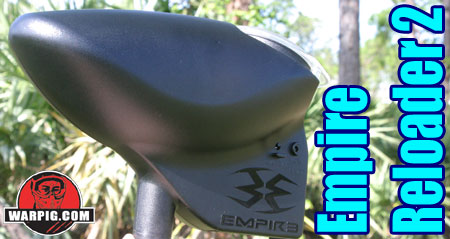  |
|
|
|
|
|
|
  |
|
|
|
|
|
|

What
do you think?
|

ReLoader 2 By Bill Mills - November 2004 The Empire ReLoader started life as the ReLoad kit. This kit was offered by National Paintball Supply as an upgrade for ViewLoader Revolution loaders. While a ReLoad upgraded Revy was still an agitating loader, the ReLoad’s electronic board changed what activated the loader’s motor. Instead of waiting for a jam to happen, and detecting it by a lack of paintballs in the neck, the ReLoad electronics were pro-active. An on-board microphone detected the sound of the paintgun shooting, and activated the agitator, causing the paintballs to be stirred up in the loader every time a shot was fired. The ReLoad kit soon found its way into a complete loader, and was made available as the ReLoader, which put the ReLoad electronics in a familiar kidney shaped loader body, available in clear, smoke or black. In the Fall of 2004 National released the next generation of the ReLoader, under the Empire brand name – the Reloader 2.
The ReLoader 2’s feed neck is rather thick, and will likely need sanding to fit into tighter paintgun feed necks or elbows. During testing for review, it even required a bit of twisting to fit into a Fireball Mountain clamping feed neck which was fully open.
The lid and fill opening themselves are nearly perpendicular to the feed neck. This means that the loader can be open, and in the process of being reloaded while the paintgun is still up and firing.
Since the ReLoader electronics are sound activated, the loader will not run itself until empty when not in use on a paintgun. Many players re-bag or pod spare paint by running their loader off-gun. In order to empty the loader, or to make sure there is not a ball jam without shooting, a quick press of the loader’s button while it is on activates the motor in a pulse lasting about one second.
The big question with loaders is always,
“how fast will it feed?” To find the answer, the Reloader 2 was run
on the WARPIG Ballistic Labs hopper test stand. The ReLoader 2 was
loaded with 100 DraXxus Hellfire paintballs. A stand mounted Matrix
LCD was electronically triggered in 10 round bursts at selected rates of
fire, with the painballs fired without a barrel, into a catch box for counting,
and to confirm that they had fed without chopping. Three bursts of
10 shots were fired at each rate, with the rate of fire increasing until
the hopper failed to feed all 10 shots on at least two of the three tries.
The ReLoader 2 combines the original
ReLoad sound activation technology with a new loader shape, innovative
hatches, and high speed agitating loader performance.
|
| Copyright © 1992-2019
Corinthian Media Services. WARPIG's webmasters can be reached through our feedback form. All articles and images are copyrighted and may not be redistributed without the written permission of their original creators and Corinthian Media Services. The WARPIG paintball page is a collection of information and pointers to sources from around the internet and other locations. As such, Corinthian Media Services makes no claims to the trustworthiness or reliability of said information. The information contained in, and referenced by WARPIG, should not be used as a substitute for safety information from trained professionals in the paintball industry. |